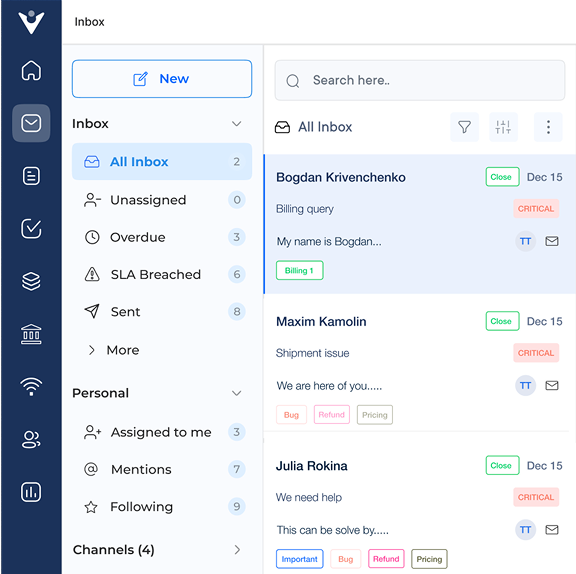1. Build Customer Loyalty through Shared Values
One of the most effective customer service retention strategies is to build customer loyalty through shared values. It involves creating a connection with customers by aligning the brand values with their own. When customers feel a strong connection to a brand based on shared values, they are more likely to remain loyal.
A great use case could be the outdoor apparel company Patagonia. It has built a strong community of loyal customers by promoting environmental conservation and sustainability. Customers who share the values are drawn to the brand and are willing to pay a higher price for their products.
Best practice:
- Communicate the brand values or mission to customers through marketing campaigns and messaging.
- Engage with customers on social media and other platforms to showcase how the brand is living out its values.
- Provide chances for customers to support brand-aligned causes through charitable partnerships or donations.
2. Frequently Ask for Feedback
Customer retention is crucial for the long-term success of any business. One effective strategy to retain customers is to frequently ask for feedback. Businesses can gather input to understand customer complaints, enhance products and strengthen relationships. It allows them to address any issues promptly and demonstrate commitment to providing exceptional customer service.
Businesses can enhance the overall customer experience and increase loyalty by implementing the feedback received. A concrete use case of the particular strategy could be a restaurant that regularly requests feedback from its patrons through customer surveys. The restaurant can find areas for improvement by paying attention to what patrons have to say. It can make the required adjustments thereafter to improve the eating experience.
Best practice:
- Utilize surveys and feedback forms to collect customer opinions.
- Encourage open communication through preferred channels for customers to provide feedback easily.
- Actively respond to customer feedback and take steps to address any concerns or suggestions promptly.
3. Get Customers Excited about a Change—or the Decision Not to
Customer retention is a critical aspect of any successful business. An effective strategy to achieve it is by getting customers excited about a change or decision not to make a specific change. It involves generating enthusiasm or engagement among customers and ensuring long-term relationships. Encouraging clients to embrace change boosts their loyalty and ongoing business relationships with the company.
One way it helps retain customers is by creating a sense of exclusivity and belonging. When customers feel excited about a change, they are more likely to feel connected to the brand. An example of it in action could be a company announcing a new loyalty program. It will keep the customers excited about the benefits to come along.
Best practice:
- Communicating the benefits of the change clearly and effectively to customers.
- Creating a sense of excitement around the change through promotions and events.
- Soliciting feedback from customers to ensure that the change aligns with their needs and preferences.
4. Treat Customers as Humans, Not Data
Treating customers as humans, not data, is important because it helps connect with customers on a personal level. Businesses can enhance trust, empathy and long-term relationships by humanizing the customer experience. It can help retain customers by making them feel valued, understood and appreciated.
One use case of the particular strategy is a clothing store that sends personalized thank-you notes to customers after their purchases. It creates a memorable experience that encourages repeat purchases. It makes the customers feel acknowledged and appreciated.
Best practice:
- Address customers by their name, send personalized recommendations based on their preferences and engage in conversations that show genuine interest in their needs.
- Actively listen to customer complaints, feedback or suggestions and respond promptly with empathy.
- Acknowledge important moments in customers’ lives, like birthdays or anniversaries, with special offerings to make them feel special.
5. Be Easy to Understand
One effective strategy to retain customers is to be easy to understand. It involves simplifying communication and processes to make it easy for customers to interact with the brand. Being easy to understand is important because it eliminates confusion for customers. When customers can easily understand the brand they are more likely to engage and make repeat purchases.
When customers feel comfortable and confident in their interactions with the brand, they are more likely to continue doing business with them. A great use case for the strategy is e-commerce giant Amazon. Amazon excels at simplicity through a user-friendly website, clear product descriptions and a streamlined checkout process. It has contributed to their high customer retention rates.
Best practice:
- Simplify the website and messaging. Ensure clear, concise messaging and user-friendly website navigation.
- Provide easy-to-follow instructions for using the products or services.
- Offer excellent customer service to address any questions or concerns in a clear and timely manner.
6. Provide Quick Delivery Options
Consumers are constantly looking for convenience and quick service in the demanding world. One way to meet demand and retain customers is by providing quick delivery options. The customer retention strategy focuses on ensuring that products are delivered to customers on time. It can be done through same-day delivery, expedited shipping, or other fast delivery methods.
Providing quick delivery options is important in retaining customers because it enhances the overall customer experience. Customers appreciate when they can receive their orders quickly, leading to increased satisfaction. Let’s consider a case study of a retail company. Providing same-day delivery enabled them to boost customer retention rates by 20% in just the first quarter of implementing the service.
Best practice:
- Partner with reliable delivery services to ensure timely and efficient delivery
- Invest in technology and logistics to streamline the delivery process.
- Offer incentives or discount codes for customers who choose quick delivery options to encourage utilization of the service.
7. Make Returns and Refunds Easy or Reasonable
One key strategy is to make returns and refunds easy to retain customers, especially when mistakes occur. It shows that a business is willing to take responsibility for errors and prioritize customer satisfaction. Businesses can increase trust with their customers by making returns or refund processes simple.
A great use case of it is the online retail giant, Amazon. Amazon’s generous return policy allows customers to easily return products for a refund or exchange, leading to high levels of customer satisfaction and loyalty.
Best practice:
- Clearly communicate return and refund policies to customers
- Provide easy and convenient ways for customers to initiate returns or refunds, like through online forms or customer service
- Offer fair and timely refunds or exchanges to customers, showing that their satisfaction is a top priority.
Customer Retention Strategies Examples
Here are some customer retention strategies examples from brands showing successful implementation and positive business impact.
1. Everly Well
Everly Well is a health and wellness brand that implemented a personalized email marketing campaign to engage with its customers. It boosted customer loyalty by sending personalized emails with health recommendations tailored to individual goals and test results. It not only improved customer retention rates but also led to an increase in overall revenue.
2. Lexy Hair
Lexy Hair implemented a customer loyalty program that rewarded customers for their purchases and referrals. The brand boosted customer retention by providing discount codes additional perks to loyal customers. The strategy helped build a strong community of brand advocates who continued to support and promote the brand.
3. Día & Co
Día & Co implemented a personalized styling service for their customers. The brand increased retention by pairing customers with personal stylists who curated clothing based on customer expectations and size. It improved the overall customer experience and led to higher customer engagement.
4. West Path
West Path is a sustainable skincare brand that educates customers on the benefits of natural products. The brand built trust with customers. It soon became an authority through education, demos and skincare tips. It improved customer retention rates and attracted new customers who were drawn to the brand’s values.
Customer Retention KPIs: How to Measure Them?
Check out the key KPIs you need to monitor and how you can effectively use them to enhance your customer retention strategies.















